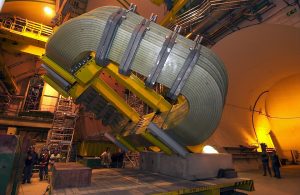
Located in a vast underground cavern, 100 metres beneath the French countryside, LHCb is the smallest of the four large experiments at the Large Hadron Collider at the CERN laboratory near Geneva, Switzerland. With its unique design optimised for matter/anti-matter studies using beauty and charm quarks, it is a project dedicated to flavour-physics measurements which has yielded many world-leading results and has exciting potential for the years ahead.
About 900 scientists, representing 81 different universities and laboratories from 19 countries, are involved in the project, with support from about 450 technicians and engineers (December 2019). The detector has a distinctive forward geometry which is chosen to take advantage of the forward- (and backward-) peaking production of b and c-quark pairs in proton-proton collisions. LHCb possesses a few crucial attributes that distinguish it from the other experiments at the LHC and make it ideally equipped for flavour-physics studies.
First, around the interaction point a precise silicon strip Vertex Locator allows the secondary vertices associated with b and c-hadron decays to be reconstructed with a high longitudinal precision. Second, LHCb is equipped with a pair of Ring Imaging Cherenkov Counters which provide excellent hadron identification, an invaluable capability when attempting to separate different decay modes of heavy hadrons. Calorimeter and muon systems complete the particle identification LHCb capability and provide key inputs for the trigger system. The latter has good efficiency for final states involving hadrons, single leptons and photons, not only the simpler signature of di muons, which is crucial for flavour physics. LHCb it is also the only experiment at LHC with a fixed target which can be operated in parallel to the high energy collisions. This opens new frontiers for physics results ranging from hadronic to cosmic rays physics and to the search for dark matter.
On November 2019 the LHCb collaboration has submitted its 500th publication. The first LHCb paper was submitted in August 2010, and since then 50 to 70 papers were submitted per year. All LHCb papers are published Open Access. The results range from search for New Physics through accurate measurement of flavour physics parameters, like the $R_K$ ratios, to QCD studies with the discoveries of new hadrons, like the $\Xi^{++}_{cc}$ baryon, and the pentaquark. From CP violation studies, where all remain consistent with the Standard Model picture including the recent discovery of the CP violation in charm particles, to the study of very rare decays like the $B_s\to\mu\mu$ measurement of the search for $K_s\to\mu\mu$. The physics program is also enriched by electroweak measurements, searches for dark matter candidates, heavy ions studies, both in collision and fixed target modes.
In 2018 LHCb completed a very successful data taking started back in 2010 (with Run 1 in 2010-2012 and Run 2 in 2015-2018), and the installation phase of the Upgrade is now in full swing. The upgraded detector will be able to readout all sub-detectors at 40 MHz and to select physics events of interest by means of a pure software trigger at the LHC bunch crossing rate of about 30 MHz. This capability will allow the experiment to collect data in Run 3 (2021-2024) and 4 (2028-2030) with high efficiency at a luminosity of $2\times10{33}cm{−2}s{−1}$, 5 times large than in Run 2. Flavour-physics measurements will be performed with much higher precision than is possible with the previous detector, and across a wider range of observables.
More than 20 people contribute to the activities of Frascati LHCb group. These include:
– data analysis (mainly the study of the very rare decays, like the $B_{(s)}\to\mu^+\mu^-$, and of the semileptonic B and $\Lambda_b$ decays through which test the Lepton Flavour Unitarity);
– operation of the muon system;
– design and test of the muon readout electronics for the upgrade 1
– responsibility of the new gas target;
– participation in the recently started Real Time Analysis project to the feasibility;
– studies for innovative muon detectors for the possible phase 2 LHCb upgrade.
Account sui social media:
– Twitter
– FaceBook
– Instagram
– YouTube
 INFN-LNF Laboratori Nazionali di Frascati
INFN-LNF Laboratori Nazionali di Frascati